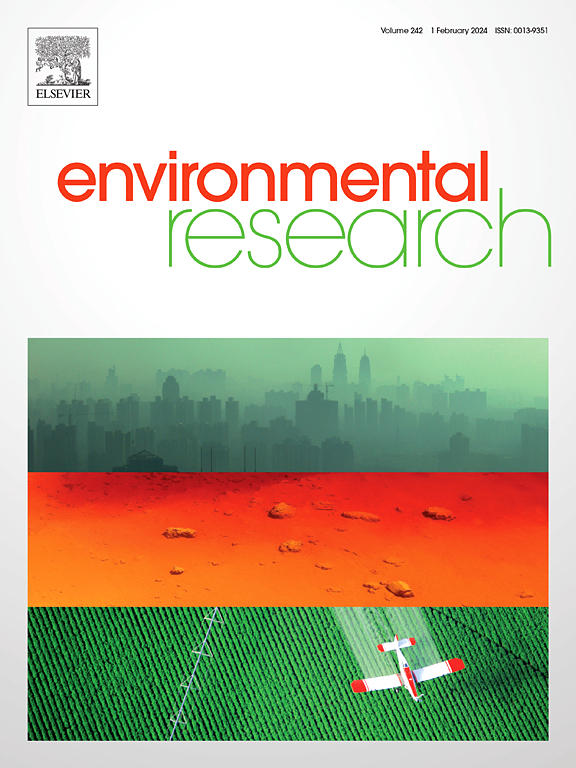Phthalate exposures, blood coagulation function, and assisted reproductive technology outcomes: Results from the TREE cohort study
IF 7.7
2区 环境科学与生态学
Q1 ENVIRONMENTAL SCIENCES
引用次数: 0
Abstract
Background
Phthalate exposures have been shown to be inversely associated with reproductive success among women undergoing assisted reproductive technology (ART). However, the underlying mechanisms are unknown.
Objectives
To explore blood coagulation function as the mediating role of associations between exposure to phthalates and ART outcomes.
Methods
A total of 735 women from the Tongji Reproductive and Environmental (TREE) study were included. Urine samples collected at recruitment were quantified for 8 phthalate metabolites, and blood clotting time and platelet indices were also determined. Generalized linear regression, logistic regression, weighted quantile sum (WQS) regression, or Bayesian kernel machine regression (BKMR) models were applied to investigate the associations among individual and mixture of phthalate metabolites, blood coagulation parameters, and ART outcomes. The mediation role of blood coagulation parameters was estimated by mediation analysis.
Results
Mono-n-butyl phthalate (MBP), mono-isobutyl phthalate (MiBP), monobenzyl phthalate (MBzP), mono(2-ethyl-5-carboxypentyl) phthalate (MECPP), and molar sum of di(2-ethylhexyl) phthalate metabolites (∑DEHP) were positively associated with platelet indices. Phthalate metabolite mixture was also positively associated with platelet count (PLT), mean platelet volume (MPV), and plateletcrit (PCT), whereas inversely associated with international normalized ratio (INR). Meanwhile, PLT and PCT were inversely associated with the odds of implantation success and live birth, while prothrombin time and INR were positively associated with the odds of implantation success. Mediation analyses showed indirect effects of above-mentioned phthalate metabolites and phthalate mixture on the odds of implantation success and live birth through PLT or PCT, with the proportion mediated ranging from 3.44% to 8.96%.
Conclusions
Phthalates may increase the risks of ART failure through enhancing blood coagulation function. More studies are warranted to verify the findings.
邻苯二甲酸酯暴露、血液凝固功能和辅助生殖技术结果:TREE 队列研究的结果。
背景:在接受辅助生殖技术(ART)治疗的妇女中,邻苯二甲酸盐暴露与生殖成功率成反比。然而,其潜在机制尚不清楚:探讨血液凝固功能在邻苯二甲酸盐暴露与 ART 结果之间的中介作用:方法:纳入同济生殖与环境(TREE)研究中的 735 名女性。对招募时收集的尿液样本中的 8 种邻苯二甲酸酯代谢物进行了定量分析,并测定了凝血时间和血小板指数。研究人员采用了广义线性回归、逻辑回归、加权量化和(WQS)回归或贝叶斯核机器回归(BKMR)模型来研究单个和混合邻苯二甲酸酯代谢物、血液凝固参数和抗逆转录病毒疗法结果之间的关联。通过中介分析估计了血液凝固参数的中介作用:结果:邻苯二甲酸单正丁酯(MBP)、邻苯二甲酸单异丁酯(MiBP)、邻苯二甲酸单苄酯(MBzP)、邻苯二甲酸单(2-乙基-5-羧基戊基)酯(MECPP)和邻苯二甲酸二(2-乙基己基)酯代谢物摩尔总和(∑DEHP)与血小板指数呈正相关。邻苯二甲酸酯代谢物混合物还与血小板计数(PLT)、平均血小板体积(MPV)和血小板比容(PCT)呈正相关,而与国际标准化比值(INR)呈反相关。同时,血小板计数(PLT)和血小板平均容积(PCT)与植入成功率和活产几率成反比,而凝血酶原时间和INR与植入成功率成正比。中介分析显示,上述邻苯二甲酸酯代谢物和邻苯二甲酸酯混合物通过PLT或PCT对植入成功几率和活产几率产生间接影响,中介比例从3.44%到8.96%不等:邻苯二甲酸盐可能会通过增强血液凝固功能而增加抗逆转录病毒疗法失败的风险。需要进行更多的研究来验证这些发现。
本文章由计算机程序翻译,如有差异,请以英文原文为准。
求助全文
约1分钟内获得全文
求助全文
来源期刊

Environmental Research
环境科学-公共卫生、环境卫生与职业卫生
CiteScore
12.60
自引率
8.40%
发文量
2480
审稿时长
4.7 months
期刊介绍:
The Environmental Research journal presents a broad range of interdisciplinary research, focused on addressing worldwide environmental concerns and featuring innovative findings. Our publication strives to explore relevant anthropogenic issues across various environmental sectors, showcasing practical applications in real-life settings.
 求助内容:
求助内容: 应助结果提醒方式:
应助结果提醒方式:


